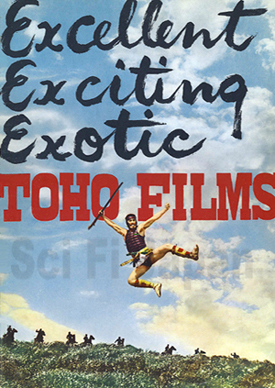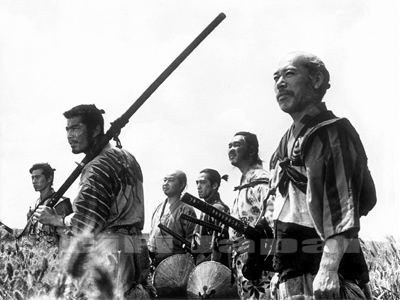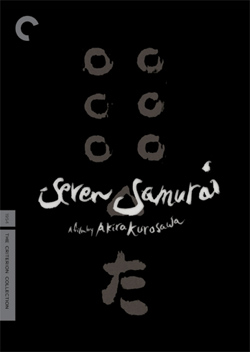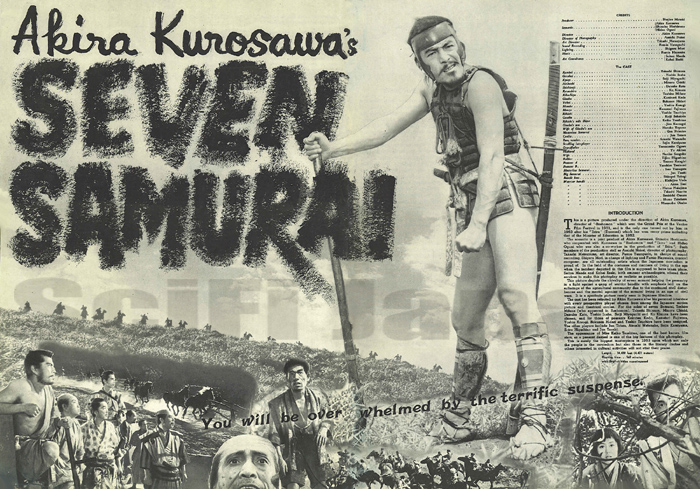Could this be the best presentation of the best movie ever made? Author: Richard Pusateri Official Site: Criterion Collection Special thanks to Stuart Galbraith IV
 Rare Toho publicity material from 1954/55 featuring Toshiro Mifune as the samurai Kikuchiyo. © 1954 Toho Co., Ltd.
Rare Toho publicity material from 1954/55 featuring Toshiro Mifune as the samurai Kikuchiyo. © 1954 Toho Co., Ltd.SEVEN SAMURAI (Shichinin no Samurai) Year: 1954 Running time: 207 minutes Black & White Aspect ratio: 1.33:1, Not Anamorphic Dolby Digital Mono 1.0 Japanese language with English subtitles SRP: $49.95 One fine day last week, I came home to find Classic Media’s GOJIRA/GODZILLA KING OF THE MONSTERS and Criterion’s SEVEN SAMURAI special edition DVD sets waiting for me. By coincidence, they arrived the same day from different retailers; both sets are from Japan, black and white, Academy aspect ratio, originally released in 1954 and they are probably Japan’s two internationally best known movies. I presume everyone visiting SciFi Japan has read Dutch’s comprehensive review of the new Godzilla release. I also expect all readers have acquired that Classic Media set or will soon. While SEVEN SAMURAI is not sci fi, it is from Japan and linked to GODZILLA. Both colossal movies were produced by Toho Co Ltd. and must have been in some stages of pre-production nearly simultaneously. They shared many crew and cast members, like Takeshi Shimura who starred in both films. SEVEN SAMURAI`s director Akira Kurosawa and Ishiro Honda, GODZILLA’s director, were colleagues and close friends. Although Godzilla might be the most famous Japanese movie star, SEVEN SAMURAI is widely accepted as the most internationally famous and critically acclaimed Japanese film. I don’t know what else I can say about the best presentation of the best movie ever made. Okay, maybe I can’t prove it’s the best, but I think this Criterion Collection release of SEVEN SAMURAI is as good as movies get, and a lot of people agree with me. You need this set. It is indispensable.
 In 1954 acclaimed actor Takashi Shimura (foreground right) played both Kambei, leader of the SEVEN SAMURAI, and Dr. Kyohei Yamane in the original GODZILLA. © 1954 Toho Co.,Ltd.
In 1954 acclaimed actor Takashi Shimura (foreground right) played both Kambei, leader of the SEVEN SAMURAI, and Dr. Kyohei Yamane in the original GODZILLA. © 1954 Toho Co.,Ltd.The Criterion three-disc restored box set of Akira Kurosawa’s SEVEN SAMURAI should be seen often by anyone (like you for example) who enjoys cinema and wants to see it done right. I hope you know it’s a long black and white samurai movie in Japanese with English subtitles. It’s the story of down and out samurai being hired by farmers to defend their village against bandits in exchange for room and board. If you will permit me a sweeping generalization, most of today’s movies are made by people who grew up playing video games and last decades’ movies were made by people who grew up watching ‘70s situation comedies on TV. SEVEN SAMURAI was made by people who grew up watching John Ford’s silent movies, and it shows in the virtuoso displays of fundamental but exquisite composition, camera techniques and editing. Made in 1954, SEVEN SAMURAI gives younger viewers a chance to see a superb action movie made without modern special effects of computer origin. How often can one see arrows actually shot into boards beneath the actors’ clothing? How often do you see the stars actually run directly into paths of horses charging down a muddy lane? I generally prefer movies that wrap up a concise story in a brisk eighty-nine minutes. However, I love every moment of SEVEN SAMURAI’s three hour and twenty seven minute running time. There’s not a wasted beat with sometimes two or even three actions taking place simultaneously in a single shot. The action flows or sweeps from scene to scene. Well, everything about this movie is superb. I would especially point out Mr. Kurosawa’s attention to the minute details of texture, whether it’s the wood grain of the walls or rain falling on a muddy road. The camera movements are stunning. See the athletic performances of the actors amplified by the camera moves! There is so much camera movement, I would expect it to be overwhelming, but it’s breathtaking. It’s a major part of SEVEN SAMURAI’s dazzling achievement. For me, trying to describe Akira Kurosawa’s masterpiece is like swimming the ocean. I’ll just recommend the eight short essays in the box set’s included booklet.
 The samurai`s flag is used as the cover art for Criterion`s new SEVEN SAMURAI DVD. © 1954 Toho Co., Ltd.
The samurai`s flag is used as the cover art for Criterion`s new SEVEN SAMURAI DVD. © 1954 Toho Co., Ltd.The “fly” I found in the DVDs’ “ointment” was the unfortunate choice of modern words or phrases in the English subtitles that 16th century Japanese warriors, peasants and farmers would most certainly not be using. Another result of carefully watching SEVEN SAMURAI is that I am no longer able to believe the oft-repeated claim that GODZILLA was the most expensive Japanese production of that time. With that many sets, cast members and costumes used in 148 days of shooting, SEVEN SAMURAI must have cost considerably more than GODZILLA did. [Research by Steve Ryfle and Stuart Galbraith IV has determined that GODZILLA cost $277,000 and SEVEN SAMURAI cost $560,000 by 1954 exchange rates.] I had the 1998 Criterion DVD edition, but I noticed the transfer seemed have excessively high contrast and a distracting shimmer or flicker effect. When I read that this set had been remastered and restored, I didn’t feel “taken” for buying a DVD I already had. The extras satisfyingly enhance the film. From Criterion’s documentation: “For the extensive restoration of SEVEN SAMURAI for this release, several different digital hardware and software solutions were utilized for flicker, instability, dirt, scratches and grain management including: daVinci’s Revival, Discreet’s Fire, Digital Vision’s ASCIII Advanced Scratch and Dirt Concealer, and MTI’s Digital Restoration System. To maintain optimal image quality through the compression process, the picture on this dual-layer DVD-9 was encoded at the highest-possible bit rate for the quantity of material included.” The packaging uses the samurais’ emblematic flag as a recurring motif. The art is appropriately dominated by earth tones and lots of stills capture the action of the battle scenes. The rest of the good news about this remastered masterpiece on two discs (and a third disc of supplementals) features: • All-new, restored high-definition digital transfer • Two audio commentaries: one by film scholars David Desser, Joan Mellen, Stephen Prince, Tony Rayns, and Donald Richie; the other by Japanese-film expert Michael Jeck • AKIRA KUROSAWA: IT IS WONDERFUL TO CREATE: a documentary on the making of SEVEN SAMURAI (50 minutes) • “My Life in Cinema”: a video conversation between Akira Kurosawa and Nagisa Oshima (120 minutes) • SEVEN SAMURAI: ORIGINS AND INFLUENCES: a new documentary looking at the samurai traditions and films that impacted Kurosawa`s masterpiece • Theatrical trailers and teaser • Gallery of rare posters and behind-the scenes and production stills • New English translation and subtitles • Booklet featuring essays by Peter Cowie (The International Film Guide), Philip Kemp (Criterion, Sight and Sound), movie producer Peggy Chiao, Alain Silver (David Lean and His Films), Kenneth Turan (Los Angeles Times), Stuart Galbraith IV (The Emperor and the Wolf: The Lives and Films of Akira Kurosawa and Toshiro Mifune), directors Arthur Penn and Sidney Lumet, plus an interview with Toshiro Mifune.
 More rare Toho promotional material for SEVEN SAMURAI, created for international sales shortly after the film`s Japanese release. © 1954 Toho Co., Ltd.
More rare Toho promotional material for SEVEN SAMURAI, created for international sales shortly after the film`s Japanese release. © 1954 Toho Co., Ltd.
